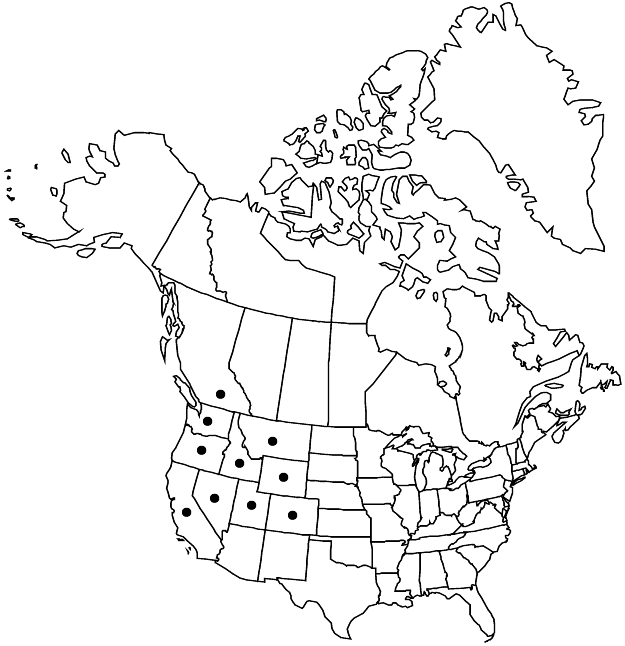Difference between revisions of "Eriogonum heracleoides"
J. Acad. Nat. Sci. Philadelphia 7: 49, plate 7. 1834.
FNA>Volume Importer |
RevisionBot (talk | contribs) m (Bot: Adding category Revised Since Print) |
||
| (3 intermediate revisions by 3 users not shown) | |||
| Line 6: | Line 6: | ||
|place=7: 49, plate 7. 1834 | |place=7: 49, plate 7. 1834 | ||
|year=1834 | |year=1834 | ||
| + | }} | ||
| + | |special_status={{Treatment/ID/Special_status | ||
| + | |code=F | ||
| + | |label=Illustrated | ||
| + | }}{{Treatment/ID/Special_status | ||
| + | |code=E | ||
| + | |label=Endemic | ||
}} | }} | ||
|basionyms= | |basionyms= | ||
| Line 19: | Line 26: | ||
-->{{Treatment/Body | -->{{Treatment/Body | ||
| − | |distribution= | + | |distribution=B.C.;Calif.;Colo.;Idaho;Mont.;Nev.;Oreg.;Utah;Wash.;Wyo. |
|discussion=<p>Varieties 2 (2 in the flora).</p><!-- | |discussion=<p>Varieties 2 (2 in the flora).</p><!-- | ||
--><p>According to N. J. Turner et al. (1980), plants of the narrow-leaved phase (var. angustifolum) were used for colds, tuberculosis, and other lung ailments, and to treat infected cuts and sores (a decoction of roots and stems). V. F. Ray (1933) reported that a decoction of roots of such plants was taken for diarrhea. E. V. Steedman (1930) said that they were taken for stomachaches, used in steambaths to treat aching joints and muscles, and had a role in a purifying ceremony held in sweatlodges. Steedman also indicated that a strong decoction was taken by the Thompson Indians to treat syphilis.</p> | --><p>According to N. J. Turner et al. (1980), plants of the narrow-leaved phase (var. angustifolum) were used for colds, tuberculosis, and other lung ailments, and to treat infected cuts and sores (a decoction of roots and stems). V. F. Ray (1933) reported that a decoction of roots of such plants was taken for diarrhea. E. V. Steedman (1930) said that they were taken for stomachaches, used in steambaths to treat aching joints and muscles, and had a role in a purifying ceremony held in sweatlodges. Steedman also indicated that a strong decoction was taken by the Thompson Indians to treat syphilis.</p> | ||
| Line 50: | Line 57: | ||
|basionyms= | |basionyms= | ||
|family=Polygonaceae | |family=Polygonaceae | ||
| − | |distribution= | + | |distribution=B.C.;Calif.;Colo.;Idaho;Mont.;Nev.;Oreg.;Utah;Wash.;Wyo. |
|reference=None | |reference=None | ||
|publication title=J. Acad. Nat. Sci. Philadelphia | |publication title=J. Acad. Nat. Sci. Philadelphia | ||
|publication year=1834 | |publication year=1834 | ||
| − | |special status= | + | |special status=Illustrated;Endemic |
| − | |source xml=https:// | + | |source xml=https://bitbucket.org/aafc-mbb/fna-data-curation/src/2e0870ddd59836b60bcf96646a41e87ea5a5943a/coarse_grained_fna_xml/V5/V5_715.xml |
|subfamily=Polygonaceae subfam. Eriogonoideae | |subfamily=Polygonaceae subfam. Eriogonoideae | ||
|genus=Eriogonum | |genus=Eriogonum | ||
| Line 62: | Line 69: | ||
}}<!-- | }}<!-- | ||
| − | -->[[Category:Treatment]][[Category:Eriogonum subg. Oligogonum]] | + | --> |
| + | |||
| + | [[Category:Treatment]] | ||
| + | [[Category:Eriogonum subg. Oligogonum]] | ||
| + | [[Category:Revised Since Print]] | ||
Latest revision as of 17:08, 6 November 2020
Herbs, spreading mats, infrequently polygamodioecious, 1–6 × 2–10, tomentose to floccose. Stems: caudex spreading; aerial flowering stems erect, slender, solid, not fistulose, arising at nodes of caudex branches and at distal nodes of short, nonflowering aerial branches, (0.5–)1–3(–4) dm, often with a whorl of (2–)5–10, linear to oblanceolate, leaflike bracts ca. midlength, 0.5–4(–5) × 0.2–1 (1.5) cm, mostly tomentose to floccose. Leaves in loose rosettes; petiole 0.5–3 cm, usually floccose; blade usually linear to oblanceolate, (1.5–)2–5 × 0.2–1(–1.5) cm, densely white-lanate to tomentose on both surfaces or only abaxially, thinly floccose or glabrous and green adaxially, margins entire, plane. Inflorescences simple or compound-umbellate, rarely reduced and compact, 1–10 × 1–10 cm; branches tomentose to floccose; bracts 3–10 or more, leaflike at proximal node, oblanceolate to linear, 0.3–1 × 0.2–0.4 cm, usually scalelike distally, 1–5 × 0.5–2.5 mm. Involucres 1 per node, turbinate to campanulate, 3–4.5 × 2.5–5(–6) mm, tomentose, rarely glabrous; teeth 6–12 or more, lobelike, reflexed, 1.5–5 mm. Flowers 4–9 mm, including 1.5–3 mm stipelike base; perianth white to cream or ochroleucous, glabrous; tepals monomorphic, spatulate to oblong-ovate; stamens exserted, 4–8 mm; filaments pilose proximally. Achenes light to dark brown, (2–)3.5–5 mm, glabrous except for sparsely pubescent beak.
Distribution

B.C., Calif., Colo., Idaho, Mont., Nev., Oreg., Utah, Wash., Wyo.
Discussion
Varieties 2 (2 in the flora).
According to N. J. Turner et al. (1980), plants of the narrow-leaved phase (var. angustifolum) were used for colds, tuberculosis, and other lung ailments, and to treat infected cuts and sores (a decoction of roots and stems). V. F. Ray (1933) reported that a decoction of roots of such plants was taken for diarrhea. E. V. Steedman (1930) said that they were taken for stomachaches, used in steambaths to treat aching joints and muscles, and had a role in a purifying ceremony held in sweatlodges. Steedman also indicated that a strong decoction was taken by the Thompson Indians to treat syphilis.
Selected References
None.
Key
| 1 | Flowering stems with a distinct whorl of leaflike bracts ca. midlength | Eriogonum heracleoides var. heracleoides |
| 1 | Flowering stems bractless, or with 1 leaflike bract ca. midlength | Eriogonum heracleoides var. leucophaeum |